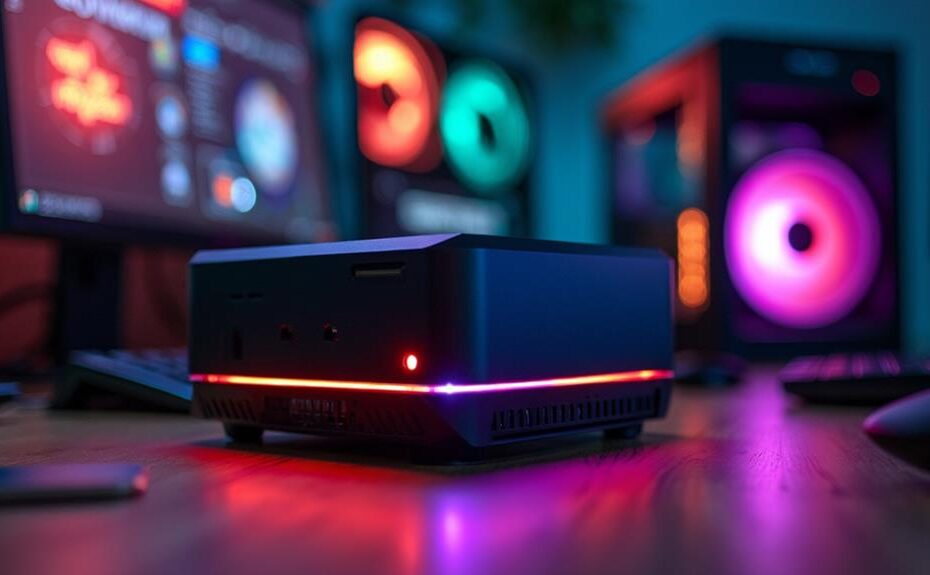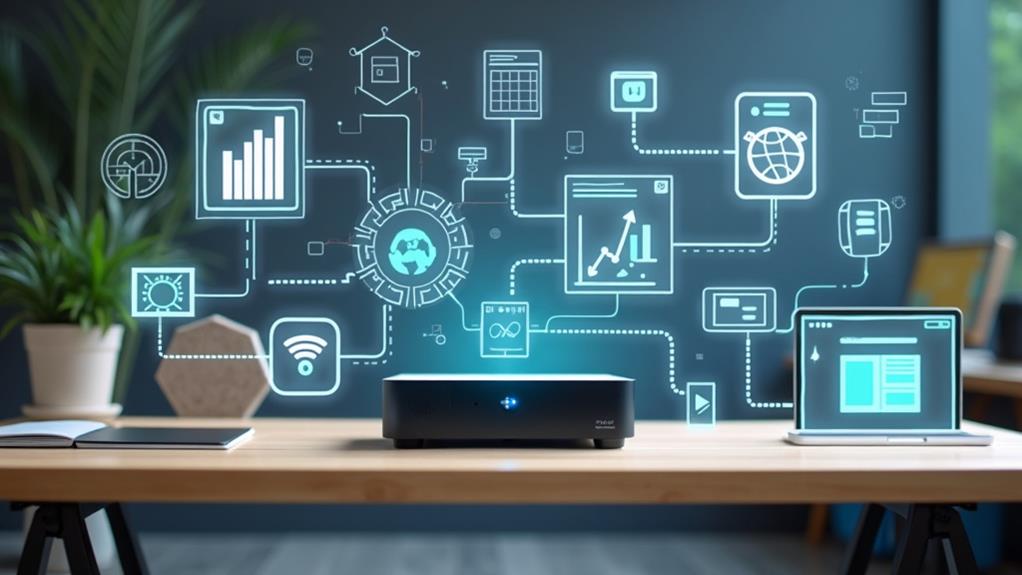



Mini PCs greatly influence the competitive landscape by expanding market growth, projected to reach $29.4 billion by 2031. They cater to the rising demand for compact devices, driving innovation among major players like Acer and Apple. These systems excel in energy efficiency and functionality, appealing to various sectors, including education and healthcare. However, they face competition from laptops and tablets, perceived as more versatile. Challenges like higher costs and limited upgrades may deter some users. Despite this, ongoing advancements suggest a rapidly evolving marketplace. Keep exploring to uncover the factors shaping the future of mini PCs.
Key Takeaways
- Mini PCs are gaining popularity due to their compact size and energy efficiency, reshaping consumer preferences in space-constrained environments.
- They compete with traditional desktops and laptops, driving innovation and diversification among established tech giants in the market.
- The rise of remote work and online education has increased demand, pushing mini PCs into sectors such as healthcare and education.
- Their lower power consumption and cost-effectiveness challenge traditional computing devices, influencing market dynamics and consumer choices.
- Ongoing innovations in AI and connectivity are enhancing mini PC capabilities, further impacting the competitive landscape of computing devices.
Overview of Mini PCs Market
The mini PCs market is rapidly evolving, showcasing impressive growth and innovation. With a market size projected to increase by USD 17.4 billion from 2024 to 2028, you can see how compact computing solutions are gaining traction in the technology landscape. Mini PCs, known for their performance and reliability, are becoming increasingly popular in various applications, including kiosks and POS systems. Between 2020 and 2023, the market volume reached 42,433.6 thousand units, reflecting an 11.2% growth. This indicates a robust demand for mini PCs, as consumers and businesses alike seek efficient alternatives to traditional desktops.
The Asia-Pacific (APAC) region stands out, dominating the market with a 39% share, emphasizing its pivotal role in shaping global trends. Major players like Acer, Apple, Dell, HP, and Lenovo are fueling this market growth through continuous innovation and diverse offerings, ensuring that you have various options to choose from.
Furthermore, the increasing importance of component specifications, particularly in the memory segment, which is expected to generate a 22% revenue share by 2031, demonstrates how consumer preferences are influencing market dynamics. This ongoing evolution of the mini PCs market highlights the importance of adaptability and innovation in meeting consumer needs.
Growth Projections and Trends
How do growth projections for mini PCs reflect broader technological trends? The global mini PCs market is set to reach $29.4 billion by 2031, reflecting a compound annual growth rate (CAGR) of 4.3% from 2024 to 2028. This growth report highlights an increasing demand for compact computing devices, driven largely by the rise of remote work and online education. As these trends continue, you can expect mini PCs to secure a more considerable market share, particularly in memory segments, which are projected to account for 22% of the market by 2031. Additionally, brands like ASUS and Intel NUC are innovating to meet these demands, offering high-performance capabilities in compact designs, which further fuels their popularity in the market high-performance capabilities.
North America currently leads this market, with expectations to hit $10.9 billion by 2031. However, the real game-changer may be emerging markets in the Asia-Pacific region, particularly China and India, which are projected to contribute considerably to global growth. By 2031, APAC is anticipated to hold a remarkable 39% market share. This shift not only underscores the growing acceptance of mini PCs across various sectors but also indicates a larger trend toward portable, efficient computing solutions, ensuring that mini PCs remain integral to the competitive landscape of computing devices.
Key Drivers of Market Demand
As the mini PCs market expands, several key drivers are fueling this demand. The projected growth of USD 17.4 billion from 2024 to 2028, with an estimated CAGR of 4.5%, highlights the increasing need for compact computing solutions. One important factor is the dominance of the APAC region, which holds a 39% market share, primarily due to the rising adoption of mini PCs in education and healthcare sectors. These devices are known for their robust processing power, making them ideal for various multimedia tasks, including performance for multimedia tasks, which enhances their appeal in diverse settings.
Their portability and compatibility with various operating systems make mini PCs particularly appealing for remote work and digital signage applications. The shift towards online learning and virtual classrooms has further accelerated this trend, as educational institutions seek efficient, space-saving solutions to enhance student engagement. Additionally, rising concerns about data privacy and cybersecurity are driving businesses and educational sectors to adopt mini PCs. These devices offer enhanced security by processing data closer to the source, which is increasingly essential in today's digital environment. Together, these factors meaningfully shape market demand, influencing the competitive landscape of computing devices and establishing mini PCs as a key component in varied industries.
Competitive Landscape Analysis
Rising competition in the mini PCs market is reshaping the landscape of compact computing solutions. As you navigate this highly competitive environment, you'll notice that established tech giants like Apple, Dell, HP, and Lenovo are ramping up their innovation efforts. They're focusing on performance, compact design, and energy efficiency to capture a larger share of the growing demand for mini PCs.
This competitive landscape features a diverse mix of players, from industry stalwarts to emerging startups, each offering unique mini PC products tailored for various applications, including gaming, education, and business. The recent shift towards remote work and online learning has intensified this competition, prompting brands to enhance their mini PCs' capabilities and broaden their target markets, particularly among millennials and educational institutions.
Moreover, mini PCs present compelling advantages—reduced power consumption and cost-effectiveness—compared to traditional desktops. This poses a significant challenge to laptops and tablets, altering the dynamics of the computing device market. As you analyze this evolving landscape, keep an eye on how these factors influence consumer choices and drive innovation among competitors.
Regional Market Insights
The competitive dynamics among mini PC manufacturers are markedly influenced by regional market trends that highlight varying demands and opportunities. In the APAC region, which dominates the mini PCs market, you'll find it contributes an impressive 39% to global market growth from 2024 to 2028. This substantial share indicates not just a high demand but also the potential for innovation tailored to local preferences. Meanwhile, North America currently holds the largest market share, projected to reach a staggering $10.9 billion by 2031. This reflects strong regional demand and suggests a robust consumer base enthusiastic for compact computing solutions.
Emerging markets in South America also present significant growth prospects, fueled by increasing tech adoption and a burgeoning middle class. Europe, particularly in countries like the U.K., Germany, and France, plays an essential role too, emphasizing the competitive landscape across various regions. With a year-on-year growth rate of 4.5% projected across regions, these regional market insights reveal that the demand for mini PCs isn't just a fleeting trend but a consistent and promising segment within the global computing device market.
Challenges Facing Mini PC Adoption
Maneuvering the landscape of mini PC adoption reveals several challenges that could hinder their widespread acceptance. While mini PCs are highly portable and offer significant advantages in size, their higher costs compared to traditional desktop computers can deter price-sensitive consumers. This price barrier limits accessibility for some demographics, impacting the overall market potential.
Moreover, limited upgradability presents a significant concern for users looking for long-term performance enhancements. Unlike traditional systems, which allow for easier upgrades, mini PCs often lack the necessary expandability, making them less appealing to tech-savvy individuals who prioritize longevity in their devices.
Additionally, fierce competition from laptops and tablets complicates the situation. Many consumers gravitate toward these versatile options, perceiving them as more practical for a range of tasks. Supply chain disruptions and component sourcing challenges further affect the availability of mini PCs, stalling their growth in the market. Finally, environmental concerns about e-waste and sustainability may also weigh on consumer preferences, causing hesitation in adopting mini PCs despite their compact advantages. Addressing these challenges is essential for mini PCs to carve out a more prominent niche in the computing landscape.
Impact on Traditional Computing
Mini PCs are reshaping the landscape of traditional computing, particularly in urban environments where space and portability are essential. Their compact design and powerful performance challenge traditional desktop computers, making them appealing to consumers who prioritize efficiency and convenience. You might notice that sectors like education and healthcare are increasingly adopting mini PCs, as these devices effectively meet specific computing needs that traditional desktops often overlook.
Additionally, mini PCs consume about 50% less power than similarly configured desktop PCs, which attracts eco-conscious consumers and businesses looking to cut energy costs. This energy efficiency not only influences individual choices but also alters the competitive landscape, pushing traditional computing manufacturers to adapt.
As mini PCs penetrate markets once dominated by laptops and traditional desktops, they showcase affordability and versatility, particularly in applications like digital signage and remote work. Major players, including Apple, Dell, and HP, are innovating within the mini PC segment, elevating competition and compelling traditional computing device manufacturers to enhance their offerings. This dynamic shift highlights the profound impact mini PCs have on traditional computing, reshaping consumer preferences and market strategies alike.
Future Outlook and Innovations
As traditional computing evolves, mini PCs are poised to lead the charge in future innovations. Their integration with advanced AI and machine learning capabilities enhances functionality, catering to tech-savvy consumers seeking efficient solutions. You'll notice that ongoing innovations in mini PC design emphasize improved energy efficiency and compact form factors, allowing businesses to optimize space while maintaining powerful performance.
The versatility of mini PCs enables seamless deployment across various sectors like education, healthcare, and retail, driving adoption in environments where traditional desktop setups fall short. As we look ahead, future developments are set to enhance connectivity options, with better support for 5G and Wi-Fi 6 emerging as essential features. This will address the growing demand for high-speed internet in edge computing applications.
Moreover, mini PCs are becoming increasingly customizable, allowing businesses to tailor solutions to specific needs. This adaptability is expected to revolutionize the competitive landscape, challenging traditional computing devices and setting new standards. As mini PCs continue to evolve, they'll surely reshape how we think about computing, pushing boundaries and fostering innovations that cater to a rapidly changing technological environment.
Disclosure: As an Amazon Associate, I earn from qualifying purchases.






